
My arduous journey in finding the perfect char siu recipe
After 9 years of research, trials and failures, I have finally succeeded in making charsiu at home. This char siu recipe is, by far, the most frustrating and difficult dish to get right. I started experimenting in 2008 with a recipe from Fatty Cheong whose charsiu is still the gold standard for me. The tender, bouncy and juicy meat melts in your mouth and melds with the crimson lacquer to coat the palate with sweet ecstacy!
It didn’t take me long to realise that this seemingly simple dish of roasted pork is so deceptively difficult to do at home. There are many recipes online and I have tried dozens. Most of them produce hypocritical charsiu that just looks like charsiu but lacked its soul.
Charsiu is typically roasted in a charcoal oven nicknamed “Apollo” by the hawkers due to its resemblance to the space capsules used during the Apollo space missions. It is in this fiery furnace that real charsiu is forged.
Strips of pork are first skewered (“char” 叉) and hung to roast (“siu” 烧). Typically, they would start by sealing the meat in a sizzling hot oven and then finishing it in moderate heat to tenderise the meat. Along the way, the strips of pork will be dunked several times in the sweet marinade until it it develops on that luscious finish.
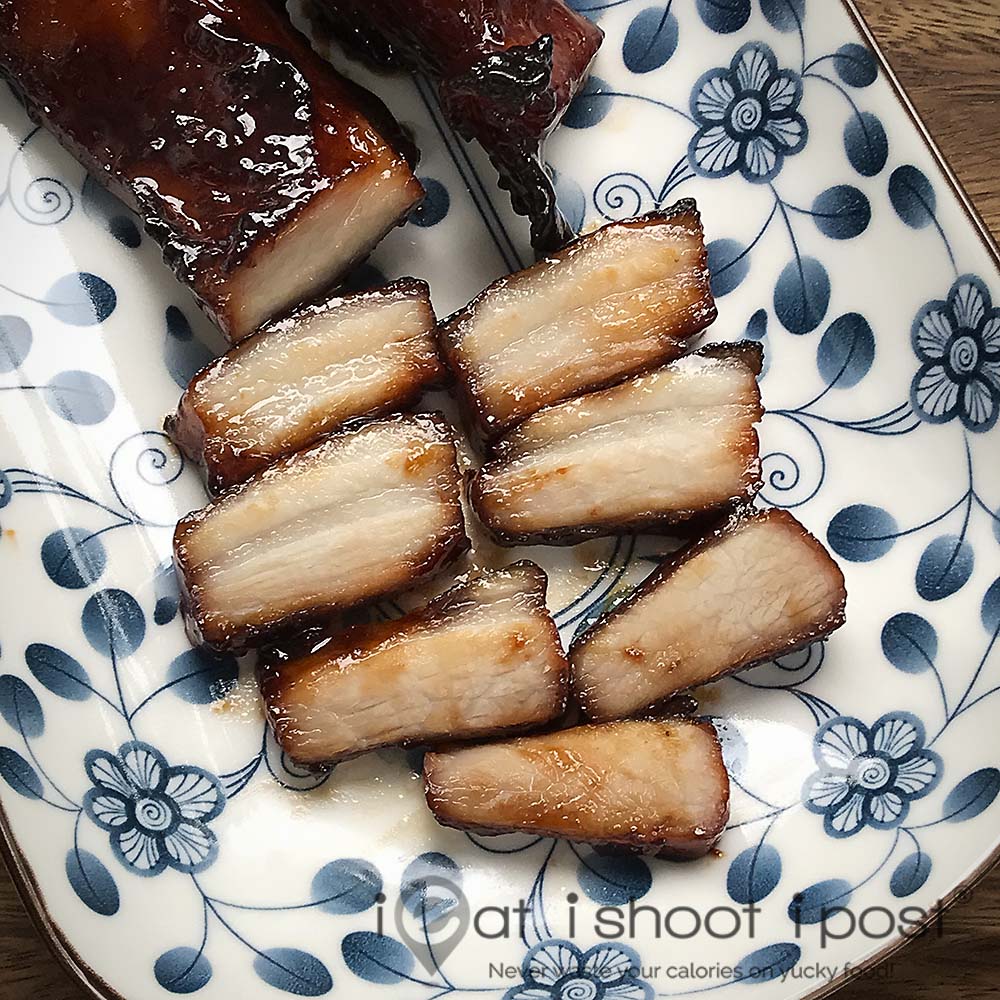
The problem is that you will not be able to reproduce this charsiu in a home kitchen using the same technique.
Here are the problems I faced:
- The meat was dry and tough
- The charsiu had that “porky” stench aka boar taint.
- The glaze tasted too much like hoisin sauce
- It lacked that “charsiu” flavour
- The lacquer was more like a sauce
I have used recipes from the internet, restaurant chefs, recipe books, hawkers and grandmas. I’ve cooked the charsiu in a sou vide bath, in a wok, in a grill, over apple wood, over charcoal, in a dutch oven, horizontally and even vertically. I have tried iberico pork, brazilian pork, collar, belly, shoulder and jowl. After years of experiments, let me tell you what I think are the most important aspects of making charsiu at home.
Most important aspects of making char siu at home
- Use the right cut of pork
- Brine it
- Cook the pork in three stages viz steam, roast and glaze.
- Charcoal flavour
I actually gave up on ever writing a charsiu recipe last year. After so many failures, I thought that making a charsiu that was remotely close to Fatty Cheong’s was an impossible task without having to buy an “Apollo”. And since my wife told me in no uncertain terms that she will never consent to having a space capsule at home, I had all but given up hope on ever making a good charsiu.
My Breakthroughs
Then I had two important breakthroughs. First was the serendipitous discovery of “charcoal oil”. This is oil that has been infused with the aroma of charcoal smoke. When I brushed this onto my charsiu, it suddenly took on that “bak kwa” flavour! This ingredient is entirely optional, but if you are a hardcore charsiu fan like myself, the addition of charcoal oil to your charsiu is that moment epiphany you have been seeking! I have included the recipe for charcoal oil in the notes.
The second breakthrough was the discovery of a charsiu recipe from “Cooks Science” which used a technique that I hadn’t tried before. The first time I attempted it, the charsiu came out quite nice but a little dry. After several modifications, the moment of synchronicity finally arrived when the charsiu that I had been chasing emerged from out of the oven.
To make sure that it wasn’t just a fluke, I have since repeated the technique four times, making minor adjustments to the recipe! So, after nine long years, I am happy to present to you Leslie’s Charsiu recipe!
Char Siu sauce recipe
The Brine
Water 1 litre
Salt 1/4 cup (50g)
The Marinade
Pork 800g – 1kg
Sugar 250g
Oyster sauce 3 Tbsp
Salted bean paste 2 Tbsp
Soya sauce 1 Tbsp
Rice wine 1 Tbsp
Black soya sauce 1 tsp
Super oren food colouring 1/8 tsp (optional)
Maltose 1/4 cup (optional)
Charcoal oil (optional)
Video showing the steps
The Method
1. Slice pork and soak in brine for 8 hours or overnight.
2. Mix all the ingredients of the marinade together over a water bath to dissolve the sugar. Cool and set aside
3. The next day, rinse off the brine and dry the pork with kitchen paper. Prick it all over with a fork (I used a special instrument for making sio bak ie roasted pork belly) and marinade for at least 1 hr or overnight. Heat the oven to 145°C (fan force). Lay strips of pork on an oiled wire rack which has been laid over a foil lined tray. Add 1/2 cup water, cover with foil and seal tight. Roast for 20 mins. Remove foil and roast for another 25 mins.
4. While the pork is roasting, pour the leftover marinade into a pot and simmer to reduce. Add 1/4 cup maltose and reduce to a glaze.
5. Remove pork from oven, switch to grill mode and raise temperature to 250°C. Glaze the pork on both sides and return to the oven. (The pork should be out of the oven for about 5-10 mins to cool) Grill for 5 mins on each side or until pork develops bits of char at the edges.
6. Finish with charcoal oil. (optional)
7. Leave to rest for 15 mins before slicing.
Important Notes:
(If your first attempt was not successful, read and study these notes!)
1. Don’t worry too much about the ingredients that go into the marinade.
That is actually a secondary issue. I have used marinades that have 15 different ingredients but the charsiu still came out mediocre with the wrong technique. The most essential part of the marinade is the sugar to which is added an ingredient for umami and saltiness like oyster sauce or bean paste. The dark soy sauce is added for colour. So the simplest recipe you can have is sugar, oyster sauce and red colouring. In fact, you can simply buy generic charsiu sauce from off the shelf, apply the cooking method and you will end up with pretty decent charsiu.
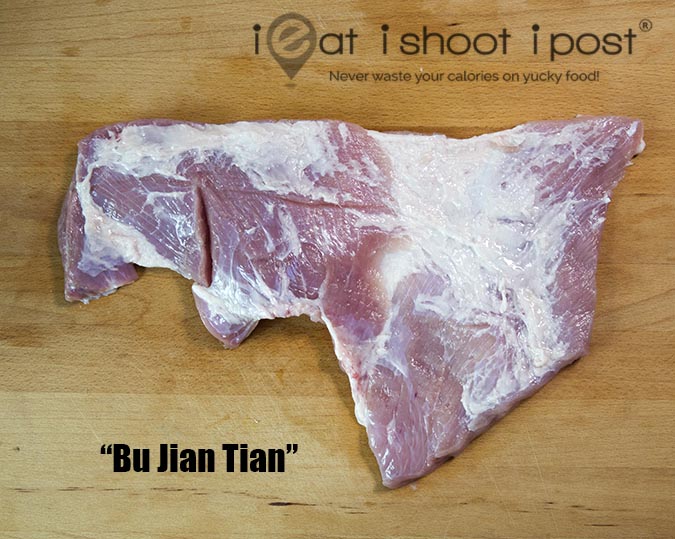
2. The cut of meat is important.
You can use belly or shoulder but I got the best results from a cut that is known locally as “bu jian tian” (不见天) which literally means “never sees the sky”. It is only available at the local wet market. If you are overseas you can use the collar, belly or jowl. Basically, you want to have a strip of meat with enough fat surrounding it so that it will remain juicy after roasting.
This cut of pork is taken literally from the pig’s armpit area ie the area of the chest just adjacent to the front leg. It is also known as “fei ji rou“飞机肉 or literally “aeroplane meat” because it is flat and resembles a the wings of an aeroplane.
The meat in this area tends to have more marbling and it is surrounded by fats such that it becomes bouncy and juicy when roasted. In the West, this part often gets turned into sausage meat. The Spanish butchers have a special cut known as the “secreto” which is taken from around this area. In our local context, the bu jian tian is valued for its culinary use for charsiu.
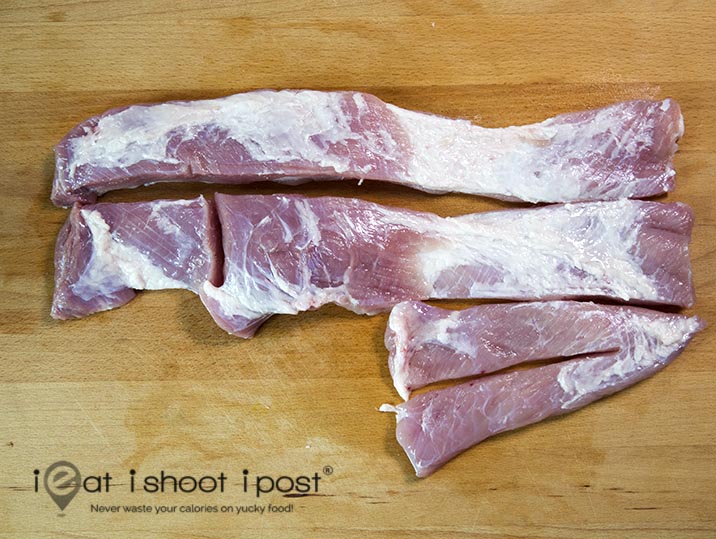
There are a few ways to cut bu jian tian for charsiu. I like to simply slice it lengthwise to produce two strips of meat. The width should be 2 inches long, about the length of your index finger. There are a few areas along these strips which have a nice bit of fat between the muscles which is what I would consider the best part of the charsiu! (like the slices in the first photo)
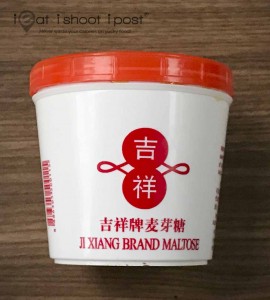
3. Maltose is important if you want the charsiu to develop a proper lacquered look.
It is thick and sticky and not very sweet and it is used to create that glassy coating when the charsiu cools down. You can omit it, but the glaze will be more like a sauce which will smear when you slice the charsiu. It will still taste good, but it just doesn’t have have that charsiu character. It is available at stores like Phoon Huat, Yue Hwa, Kwong Cheong Thye and the bigger supermarkets. Honey can be used as a substitute but it doesn’t work as well as maltose.
4. Charcoal oil is the secret for making a charsiu that tastes like those cooked in a charcoal oven without actually having to cook it in a charcoal oven.
You really need to try it to believe it. Just a quick brush with charcoal oil and suddenly the charsiu takes on that bak kwa flavour! To make charcoal oil, you simply put a piece of charcoal which has burnt through until it is covered with white ash (it’s still hot) into a pot of neutral oil (I used grapeseed) cover the pot with the lid and leave it for a few hours. Remove the charcoal and strain it and you will get a very versatile oil that you can use to make anything taste like its been cooked over charcoal. Best time to do this is when you have a BBQ. At the end of the BBQ, when the charcoal is cooling down just throw a chunk into some oil and cover it!
5. There are three reasons to brine the pork.
First it helps the pork to retain more water. Second, it tenderises it and thirdly, soaking the pork in water helps to remove the boar taint. You can omit this step if you don’t have time.
6. It is important that you remove the charsiu from the oven for a while to let it cool down after the initial 45 min roasting.
So take your time to glaze the pork while you wait for the oven to heat up to 250°C. The pork is essentially cooked already and you don’t want to overcook it. The final grilling stage is where the pork develops that glaze and char.
7. Salted bean paste adds umami and flavour to the dish
This is the component which you can alter to give your charsiu a more nuanced flavour. The local salted bean pastes tends to be quite salty and different brands will have different levels of saltiness. This recipe is based on a local salty bean paste. If you are using a less salty version, you may have to add a teaspoon of salt to the marinade or more bean paste. How do you tell? Well, when all the sugar has dissolved in the water bath, taste the sauce. It should taste sweet with enough saltiness so that it doesn’t taste like a dessert, a balanced taste t It should just taste like the sweet sauce that you would add to your peking duck or chee cheong fan.
For a more nuanced flavour, you can use Japanese miso or fermented bean curd. I personally like to use a Taiwanese fermented bean curd with soy beans. It has a sweet alcoholic aroma which gives the charsiu a nice flavour. If you want a natural red colour without the use of food colouring, red yeast rice can be used. Again this will add an interesting dimension of flavour to the charsiu. I don’t like hoisin sauce. I have tried many recipes which call for hoisin but it always comes out too strong. If you like hoisin you can add a bit of it, but not too much or it will just overpower the charsiu.
8. Chinese wine gives it a nice floral aroma and helps to rid the pork of its boar taint.
Again, this is a component which you can play around with to give your charsiu a more unique flavour. Hua diao jiu is dependable but you can use other spirits like bai jiu (白酒)or rose wine (玫瑰露酒) which will give the charsiu a aroma like lup cheong, sherry, sake or even XO brandy. You can actually leave it out altogether if you don’t have any handy.
9. I use black soya sauce essentially for its colour.
It turns your charsiu sauce into that dark mahogany colour. Different brands of dark soy sauce will produce different colours. Some are more red than others. If you can find one that is red enough, you won’t have to use food colouring.
10. Food colouring is not essential but charsiu that is dark brown without any tinge of red doesn’t look like charsiu.
We do eat with our eyes, so if you want to impress, a tinge of red colouring makes a world of difference to the charsiu. The one that the hawkers use is “Super oren” powder which you can buy from the wet market. You can use red yeast rice or red fermented bean curd to substitute.
11. Use a water bath to make the sauce
Lots of recipes simply tell you to add the components to the pork strips and marinade. But my advise is to make the sauce first over a water bath. Because your ingredients will not be exactly the same as mine, so by mixing the sauce first, you get to taste and adjust your marinade properly before adding it to the pork. If it is too salty, add more sugar, if not salty enough add a bit more light soy sauce or salt. It should taste like a nice peking duck sauce when it is done. Leave it to cool before adding to the pork.
12. Make sure that you dry the pork properly before you add the sauce.
Stalls outside hang the charsiu and baste it a few times to build that layer of lacquer. By hanging the charsiu, excess moisture drips down and the surface gets dry and readily absorbs the next basting of the marinade. We are using a different technique where we only apply a final layer of glaze. So in order to maximise penetration of the marinade, we dry the outside of the pork and prick the surface to get it ready to absorb the marinade. If the surface of the pork is wet, the marinade will not be absorbed easily. I prick the surface and dry it thoroughly with paper towels before adding the marinade. It would be even better if you put it on a rack and allow the surface to dry in the fridge for a few hours. By that time, the water would have evaporated from surface of the pork and when you add the marinade it would absorb it like a sponge.
13. Some of you might baulk at the amount of sugar used.
As I mentioned earlier, sugar is the main component of the charsiu recipe. This recipe should yield enough marinade for up to 1.5kg of charsiu. Not all of the marinade will be used. Most of it will be thrown away in the end. But you need enough of it to cover the amount of pork during the marination phase. After reducing it, you are only giving your charsiu one coat of the glaze. The rest is thrown away so you are not actually eating so much sugar. Having said that, this is not a dish for you if you are suffering from diabetes.
14. Oven temperatures will vary so you may have to experiment a few times before you get the texture you want.
I use 145°C fan forced mode for roasting. Essentially, you want to keep the temperature of the pork between 72°C and 82°C. At this temperature, the collagen in the pork breaks down and turns to gelatin. If it is too high, the protein fibres will contract and squeeze out the gelatin making your charsiu dry and stringy. If you like your charsiu more tender you can add another 5-15 mins to the roasting time.
Happy Cooking and tell me how you went!
Other similar Hawker Food Recipes:
Char Siu
Har Cheong Gai
Roast Chicken
Places to eat Char Siu:
Shi Mei Roasted
Kim Heng Roasted Meats
Mei Mei Roasted Duck
Fatty Cheong
Choon Kee Roasted Delights
Disclosure: Some links above are affiliate links, meaning, at no additional cost to you, a small commission is earned if you click through and make a purchase.



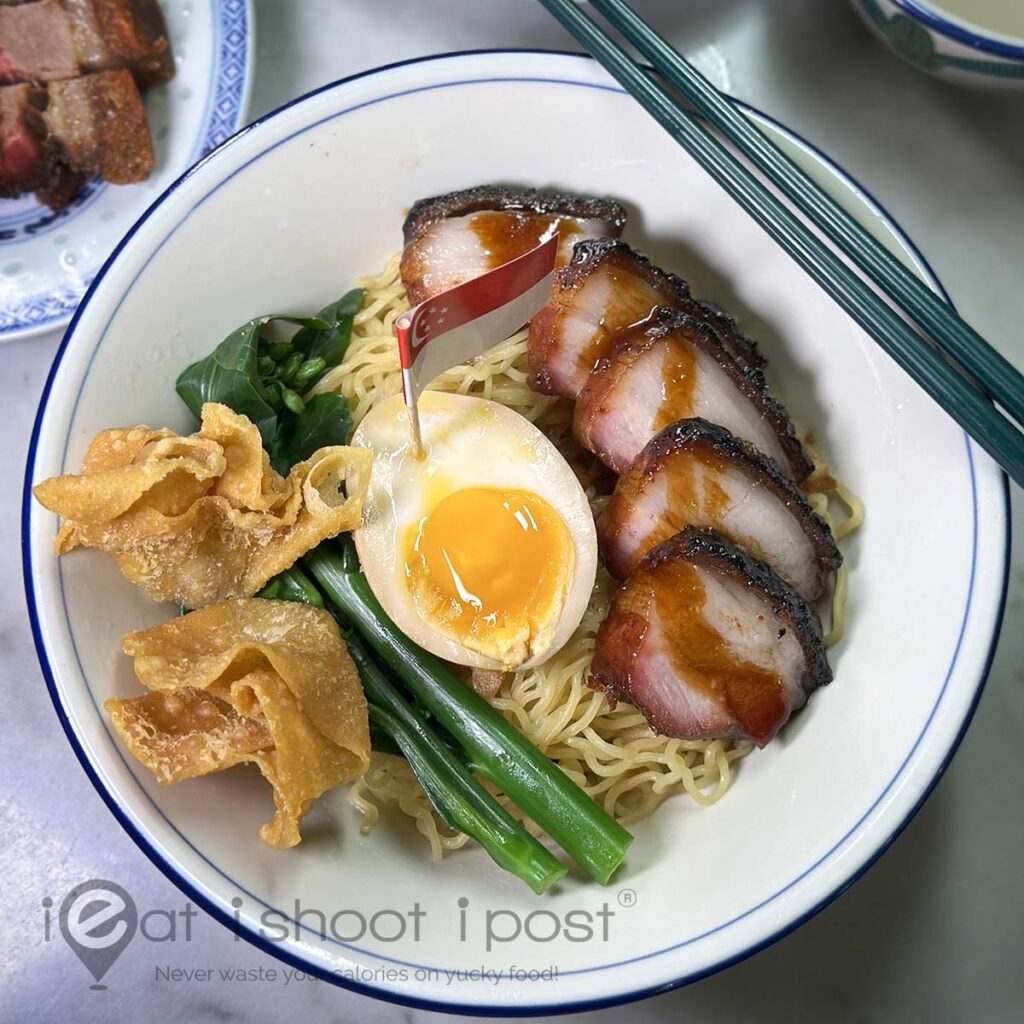
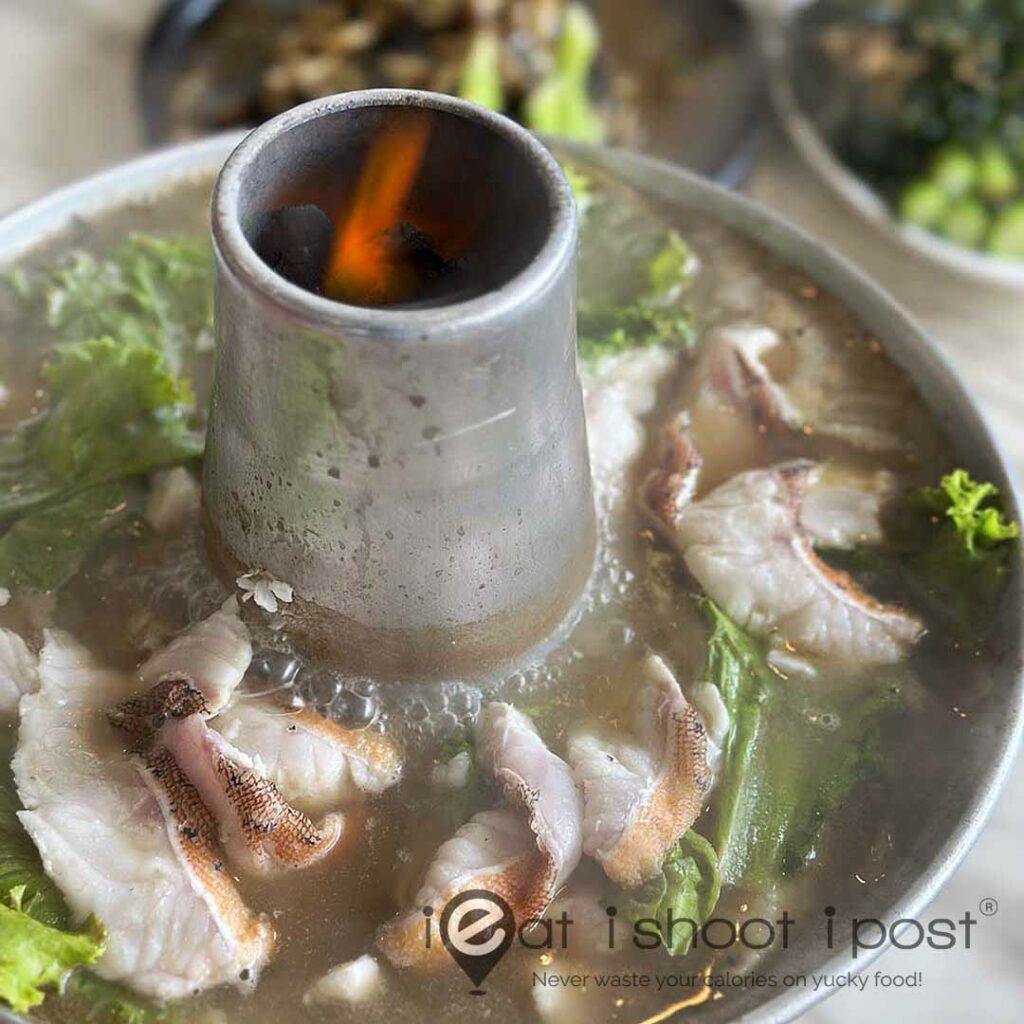
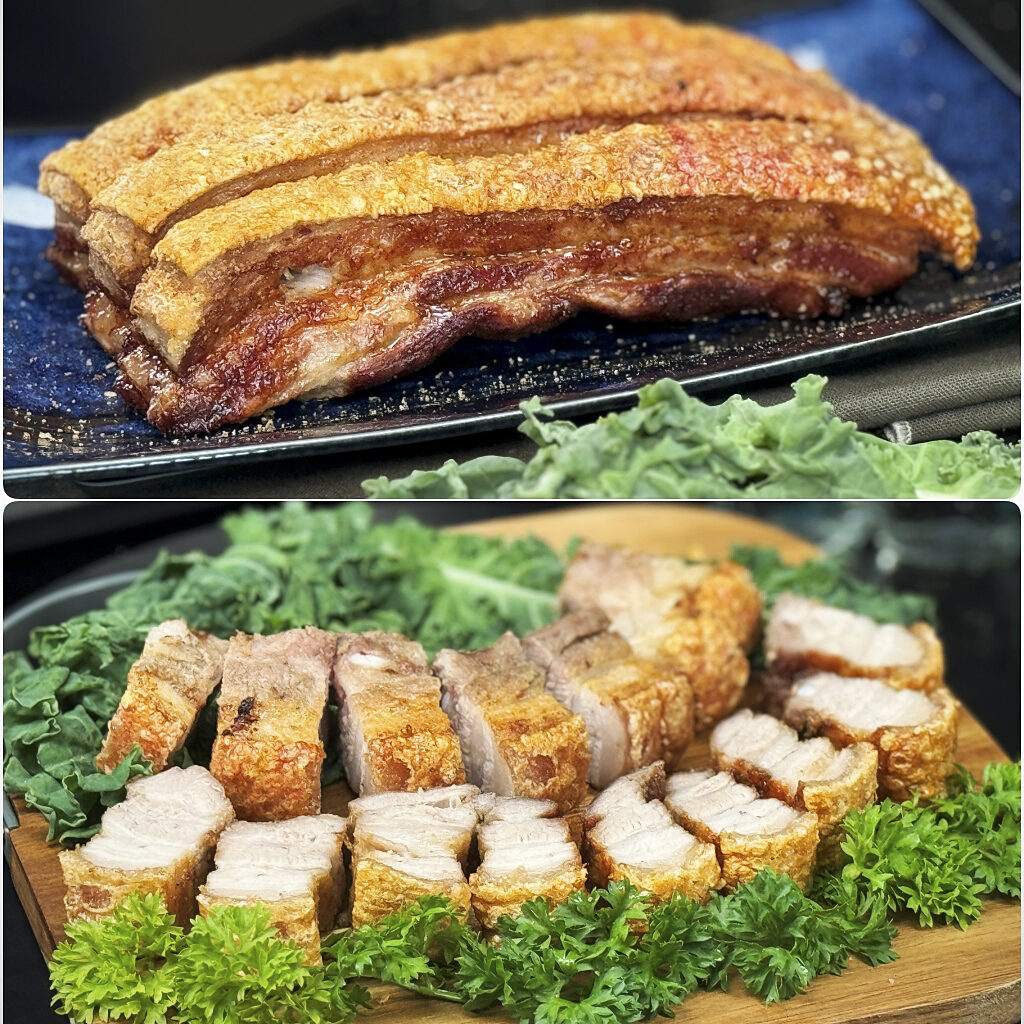
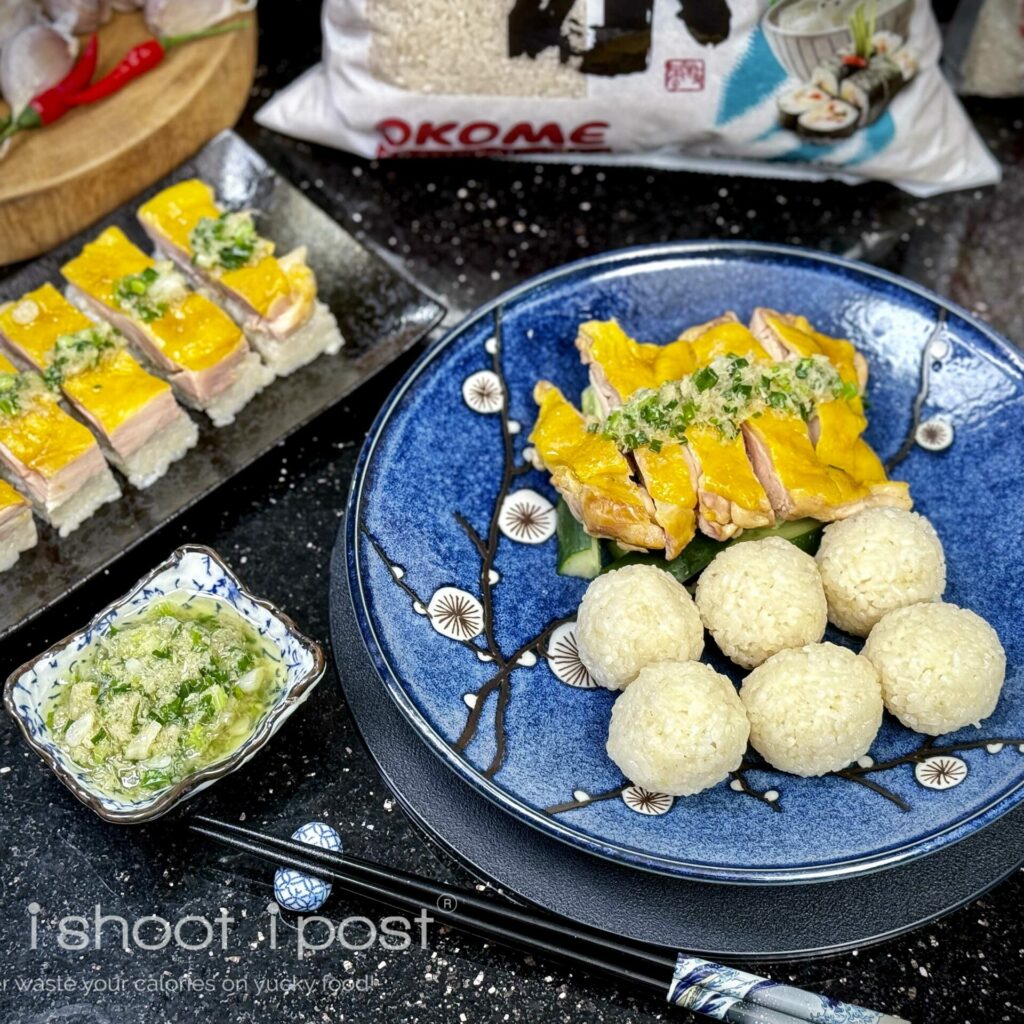
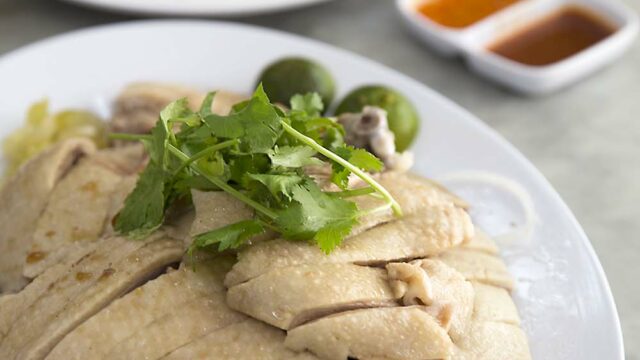




I feel like once you start playing with the sous vide techniques this will be updated.
Been there, done that.
Woah.
Just want to ask, do i need to fridge the meat when brining and marinade it? Thanks. Mary
Yes you do!
Followed the receipe to a T and the char siew turns out great! it was juicy and flavourful. There is a small issue that I can’t comprehend though. The skin is slightly chewy. Should I remove the skin or is there something I have done wrong that result in the chewy skin.
It has to do with the malt. Maybe you can reduce the amount a little. If you leave it out altogether, it will not be chewy.
Yes you do.
Yes, leave it in the fridge.
Tiger brand is fine but it is a little salty.
I don’t know. Haven’t tried it. As far as I am concerned, this gave me the char siu I was looking for all these years, so there is no need to try to find another method that works.
are there any alternatives/substitutes for the maltose that you recommend?
Honey
Thanks for the recipe and techniques! Would love to get my hand on some charcoal oil the next time, but otherwise the best review was from my toddler daughter who dug through her rice to hunt for the char siu 🙂
If i marinate the meat overnight do you let it thaw to room temperature before throwing it in the oven?
Yes you do.
can this technique apply for chicken?
txs
You probably don’t have to cook as long for chicken.
Hi. May i know what kind of brine recipe did you use?
5% brine. It is listed in the recipe.
Hi Leslie, made a char siew flavoured turkey (as my husband’s given up pork) with your marinade and it was a big hit with my guests. Omitted the rice wine since it won’t have the porky smell, and didn’t have the charcoal oil. But am looking forward to making the flavoured oil at the next barbecue (which may be in a few months when the weather warms up. Am sharing your post as my friends are asking for the recipe.
Btw, I truly appreciate your dedication to getting your recipes just right. I tried your pandan cake couple of years back and it was deliciously authentic too.
Hi Grace, thanks for the encouraging words! Merry Christmas and a Happy new year!
I have a Char Siew recipe that uses Hoisin Sauce as one of the ingredients for the Marinade. Haven’t tried your marinade but I do like your method. However if I were to use my marinade of a mixture of Hoisin Sauce, Maltose, Honey, Soy sauce, Rose Wine, Sesame oil, Pepper but your method of cooking, is it advisable to add another 1/4 cup Maltose & then baste to give it that Nice Sticky Glaze? Or omit as my marinade already has maltose & may make it too sweet? Also, can u brush the Marinade on when u remove the foil & roast it at 145C or only during the Broiling/Grilling time? Thanks a lot if u can reply! ( Btw, I have tried a few of your recipes & they have turned out really authentic & great. ?)
Actually, I would advise that you leave out the maltose from the marinade and add it when you reduce it for the basting sauce. You may brush some of the marinade on when you are roasting it but I don’t think it is necessary. I used to have Hoisin sauce too, but I found the flavour too strong, so I prefer not to have it.
Hi Dr
Can share where you got the aluminium tray and wire rack?
Sia Huat.
Hi Dr. Leslie,
Where can I get the prick for making sio bak?
Try Sia Huat or Lau Choy Seng at Temple st. Some neighbourhood stalls actually sell them too.
My oven is a gas oven that does not have a fan or grill feature. I could really only broil the meat by bringing it to the highest rack. Based on your experience, what temperatures should I set my oven to during the steam, bake, and grill phases?
Can I replace the rice wine with rose wine?
Sure!
I have done this recipe and it was good but this time i am using about 500g pork belly. Will the roasting time be the same, i.e. with foil for 20mins and without foil another 25 mins? Grilling time at high heat to char the exterior should be the same?
Hi doc
Stupid question but do you remove the skin when you use pork belly to make the char Siew?
If you buy it from the market, you can get the butcher to remove the skin for you. If you do yourself, first you slice off about 2 inches of skin from one corner. Then, you slidce a hole in the skin and so that you can put your finger in it. This helps to anchor the skin. Next place your knife in between the skin and the meat. Put some pressure on the knife, angling it 45 degrees towards the skin and pull the skin towards you in a side to side motion.
Followed your recipe down to it’s last word – everything went well. However, the meat is a bit salty. Have you experimented with a brine of perhaps 4% salt w/v? Do you think it’ll still work?
If your pork is well marbled, you can do without the brine. You can try 4% or even 3% brine.
Used bu jian tian, brined overnite, then marinade overnite. Covered with foil and roast 20 mins, removed foil and roast 30 mins then finally baste and roast each side 5 mins. Taste was good but texture of meat is not tender. My oven doesn’t have fan and grill functions. Roast at 145C with both upper and lower heat. For final 10 mins only use upper heat. Please advise why the meat is not soft and tender. Thanks
Yes, it really depends on the quality of your pork as well. Sometimes, it is too lean and so it is tough. Try again with another piece of pork.
Hi Leslie. Thanks for the great tips and recipe. I never made char siew before until I tried your recipe. This is a really good recipe and I have been recommending your recipe to others. I have tested using German pork, and several cuts of Iberico pork. I have to admit the best is the Iberico Pluma. My family says this is the best char siew ever. Thanks for sharing!
Wow, glad you like the recipe! Thanks for your recommendation of Iberico Pluma! I will have to try it one day!
Hello! This recipe is wonderful and we always end up regretting not making enough. Now, the prob is that we’ve made too much! Any tips on storing + reheating leftover charsiew? 🙂
Oh, you can just freeze it and reheat it when you need it! Glad you like the recipe!
I can never get the Char Siu to have bits of char!!! What can I do?
Is it my grill not powerful enough? Its at 250C
Place the charsiu nearer to the grill. Did you reduce the sugar in the marinade? It is difficult to get the charred bits if there is not enough sugar.
Being diabetic, I missed eating char siew! I modified your recipe to 150g of Lakanto (monk fruit sweetener), added 2 pcs of red fermented bean curd, reduced bean paste to 1 tbsp, omitted the optional items ie maltose, oren food colourng & charcoal oil. Didn’t brine the meat first, but marinated for 1 day + overnight.
Char siew turns out great! Thank you Dr Leslie for sharing your perfected recipe and appreciate your thoroughness & explanatory notes!
Great! Glad you enjoyed the recipe! Thanks for sharing!
Dear leslie can i check with you where u get the charcoal oil please
Hi Ashley,
You have to make it yourself. The instructions are given in the post.
Hi Dr Leslie, great great recipe, cant wait to try it out this week. what went wrong in the sous vide version? curious as i have a sous vide machine
I only use sous vide if it is better than conventional cooking.
Hi Doctor! Thank you for the recipe. Mey I know what type of charcoal did you use for the oil because there is no bbq fragrance for mine but only chao tah smell.
Just normal charcoal
Thanks for the reply. Im still trying it out. Im using grapeseed oil and normal charcoal too but the oil smelt awful sort of burnt smell, should it be this smell? Or the nice bbq bakkwa smell?
“Roast for 20 mins.” I gather this is the “steaming” step using the oven. Wondering whether using Pressure Cooker to do this steaming step instead will yield a more tender and melt in your mouth char-siew after the final oven-grilling (broiler) step. Maybe even replace the 25mins convection roast as the pork is essentially cooked & already soft with the Pressure Cooker as the 1st step. Appreciate your views. Thanks.
The recipe is perfect as it is. You can try these other ways, but after experimenting with so many different techniques, I have settled on this and have been using it ever since. Never felt I needed to improve on it except if I can get hold of a charcoal oven.
Hi doc, I managed to buy bu jian tian fr sheng siong supermarket, but the trays of meat come with the skin on, do I have to remove skin before cooking it or will it turn soft with yr method?
Yes, you need to remove the skin. I find the bu jian tian meat from Sheng Shiong a little thin, though.
Hi,
Why you dont put 5 spices powdrr in the marinade ?
I sometimes do, but it doesn’t really need it. Roast pork needs 5 spice.
Wgere can i buy the charcoal oil ?
You make it by putting a piece of hot charcoal into oil and covering the pot with a heavy lid.